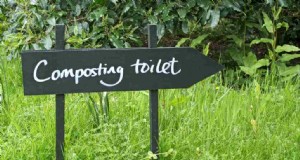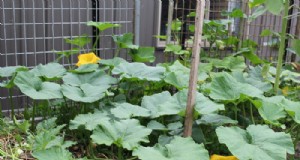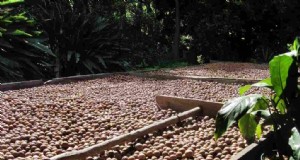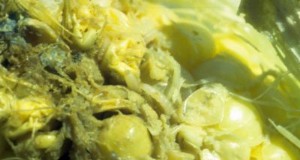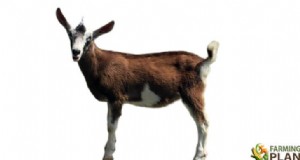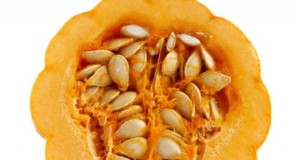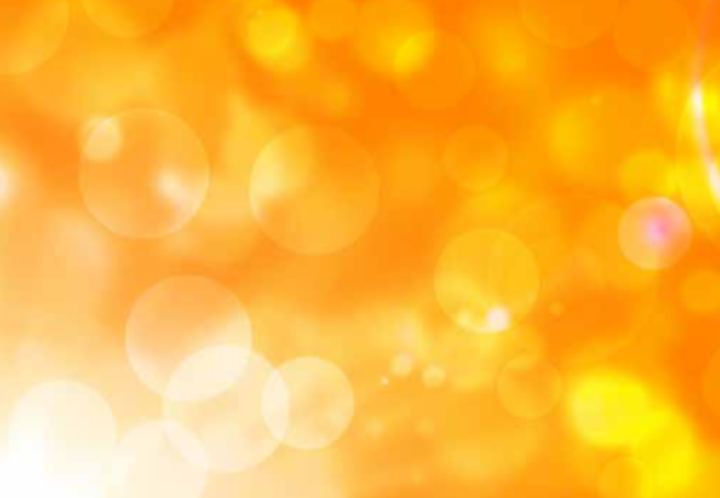ESTANQUE S
En naturaleza, muchos peces nunca alcanzan el tamaño adulto porque son devorados por otros animales o depredadores o mueren por enfermedades o falta de oxígeno. El cultivo de peces en estanques intenta controlar la situación para producir más peces. En los estanques se puede controlar a los depredadores para que el estanque produzca más peces que las aguas naturales. El crecimiento de los peces en los estanques se debe principalmente al hecho de que los peces no pueden escapar, y alimentando, cría, El cultivo y la recolección del pescado se lleva a cabo de forma bien planificada.
La piscicultura se practica en estanques. Estos son pequeños cuerpos de agua poco profundos en condiciones naturales y completamente drenables, generalmente construidos artificialmente. Los estanques naturales se diferencian de los lagos por tener una zona litoral relativamente grande y una pequeña zona profunda. Su fuente de agua también puede variar.
H es o r y
El cultivo de peces en estanques es una práctica muy antigua. Los peces se cultivaron ya en 2698 a. C. en China. La piscicultura parecía ocurrir siempre que la civilización se asentaba durante un largo período de tiempo. La piscicultura se realizó en el antiguo Egipto y en China, que ha tenido una civilización continua durante más de 4000 años. El primer relato escrito de cultivo de peces en estanques fue de Fan Lai, un piscicultor chino en 475 a. C. Los antiguos romanos introdujeron la carpa de Asia en Grecia e Italia. En el siglo XVII, el cultivo de la carpa se practica en toda Europa.
W h y fi s h gramo o w I norte correos norte D s
La práctica de la piscicultura en estanques es más ventajosa. Es más fácil capturar peces de un estanque que capturarlos de un recurso natural. Se puede controlar el crecimiento de los peces. Los peces pueden ser alimentados con alimentos adicionales para mejorar su valor de mercado. Se puede evitar que los enemigos naturales maten a los peces en los estanques. Los peces pueden protegerse de las enfermedades. En estanques la producción de pescado se puede incrementar con la gestión científica y se pueden generar más ingresos. La piscicultura puede ayudar al agricultor a hacer el mejor uso de la tierra. El avistamiento de peces también puede proporcionar ingresos adicionales.
T y Educación física s o F fis h granja s
Hay dos tipos principales de explotaciones pesqueras que se basan principalmente en la naturaleza de la cría.
1. Las piscifactorías en las que se crían peces para la cría de alevines y alevines.
2. Las piscifactorías en las que se crían los alevines o alevines hasta un tamaño comercial. El agricultor tiene que decidir qué tipo de piscifactoría va a iniciar.
B a s mi D o norte Wat mi r sorber pag l y t o pon D s , t h mi y Arkansas mi cla s si F es decir D I norte t o 5 t y Educación física s .
S pri norte gramo Washington te r pag ond s :Los estanques de agua de manantial se abastecen de agua subterránea, ya sea a través de manantiales naturales en su fondo o a través de otros que se encuentran adyacentes a ellos. El agua de manantial es buena para el cultivo de peces porque está limpia y no contiene peces no deseados ni huevos de peces. Si el manantial ha recorrido una gran distancia antes de drenar en el estanque, puede tener contaminantes y debe filtrarse antes de su uso.
R a I norte Washington te r pag o norte D s :Estos también se denominan estanques del cielo. Estos están llenos de agua de lluvia y la extensión de su llenado depende de la cantidad de lluvia.
W mi l l w a te r pon D s : Estos están llenos de agua de pozo y se consideran muy buenos para la piscicultura. Se les puede suministrar adecuadamente agua que no tenga contaminantes.
F l o o D pl a I norte buey - B o w pag sobre D s :El agua para estos estanques es suministrada por el arroyo. Estos son altamente productivos debido a la acumulación de materiales orgánicos y las inundaciones periódicas.
W a mi r C UNED r s mi pag sobre D s : Estos estanques se colocan en el curso de agua corriente y se dividen en dos tipos principales.
B a se D o norte w a t mi r s tu personas y , s o I l a norte D t o pag ogra pag h y t h mi pag o Dakota del Norte s Arkansas mi o f cinco tipos.
Muchos aspectos de la construcción de estos estanques son los mismos. La principal diferencia entre estos es la fuente de agua. Estos son :
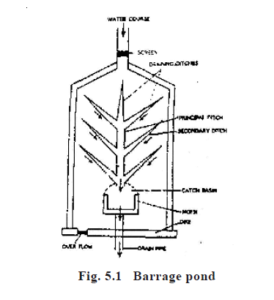
B a r real academia de bellas artes gramo mi pag sobre D s : Estos estanques generalmente se llenan con lluvia o con agua de manantial. Un manantial por ejemplo, envía agua que fluye a través de un pequeño valle o por una pendiente hacia un lugar bajo. O, un manantial burbujea desde el suelo en una depresión natural. El estanque se forma recolectando agua en la base del valle y en los lugares bajos. El agricultor hace esto mediante la construcción de un muro o presa que contiene el agua en el interior, ahora que, es el área del estanque. El número de paredes de estanques que se deben construir depende del terreno y del sistema de drenaje. Un estanque de presa generalmente necesita solo una pared:la pared principal entre la fuente de agua y el área del estanque.
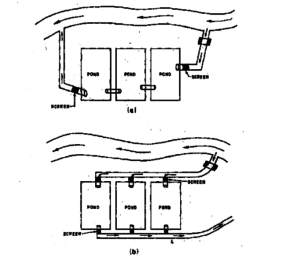
D ivers I o norte estanque s a ) Ro s Arkansas y sistema metro B ) PAG aralle l s y ste metro
Se utiliza un tipo de sistema de drenaje llamado carro de esclusa para permitir que el agua entre y salga del estanque. También hay una serie de sistemas de drenaje sencillos que se pueden utilizar y que no requieren ninguna construcción complicada.
Los estanques de presa (Fig. 5.1) no deben construirse donde el flujo de agua sea demasiado grande, ya que es difícil evitar que el agua rompa la pared si la presión del agua es demasiado grande. Arroyos y arroyos que fluyen bien, pero no demasiado fuerte, son buenas fuentes para estanques de presa.
Incluso cuando el flujo de agua no es grande, sin embargo, los estanques de presa requieren canales de desbordamiento. Debido a que los estanques de presa generalmente se construyen en áreas bajas, es probable que se llenen durante las fuertes lluvias. Los canales de desbordamiento constituyen cualquier tipo de sistema que se puede configurar para evitar que el estanque acumule demasiada agua. El desbordamiento quita agua extra del estanque. Si esta agua adicional no se drena, la pared del estanque puede romperse.
D he r sio norte pon D s :
Estos estanques se hacen desviando agua de otra fuente como un arroyo o río. Se cavan canales para llevar el agua desde la fuente de agua hasta el estanque. Los estanques de desvío se pueden construir de varias formas. A veces, un estanque se excava en un terreno plano o se puede construir agrandando ligeramente una depresión natural en la tierra. Estos estanques requieren paredes dependiendo de la topografía del terreno, el sistema de drenaje, etc.
En estanques de derivación (Fig. 6.2), el agua siempre se lleva al estanque a través de canales de desviación en lugar de correr directamente al estanque. El agua se puede desviar de varias formas. Un pequeño arroyo que obtiene su agua de un arroyo más grande cercano se puede represar y usar como canal de desvío para alimentar un estanque. Los estanques de desvío se pueden construir de dos formas.
R osar y sy s te metro :
Estos estanques se construyen uno tras otro en una cadena. Todos los estanques se drenan entre sí y deben manejarse como si fueran un solo estanque. Si el primer estanque de la serie con entrada de agua está lleno de depredadores que deben estar envenenados, todos los demás estanques deben recolectarse y drenarse antes de que el primer estanque pueda ser envenenado.
PAG aralle l sistema :
Cada estanque tiene su propia entrada y salida. Por lo tanto, cada estanque se puede gestionar como un estanque independiente. El sistema paralelo es un sistema mejor. Pero los sistemas de rosarios son más baratos y fáciles de construir. Si la fuente de agua es buena, y puede mantenerse libre de depredadores, y si la gestión del estanque se hace bien, este es un sistema mejor y más barato.
Los estanques de desvío son siempre mejores que los estanques de presa. Esto se debe al hecho de que es menos probable que se desborden y la fuente de agua es más confiable durante todo el año. Estanques de presa, sin embargo, requieren menos construcción y es probable que sean más baratos.
PAG ond s metro a y Alabama s o B mi C las s ifie D a C C ordin gramo t o th ei r s iz mi un D tu hundimiento mi en a pez granja dentro cinco tipos
Estos se construyen de acuerdo con los requisitos del pez o sus etapas de ciclo de vida. Estos son:
H ea D correos norte D :Este estanque generalmente se construye cerca de una fuente de agua perenne. El objetivo principal del estanque es satisfacer las necesidades de agua de toda la finca, teniendo en cuenta las pérdidas por filtración, evaporación, etc.
H a C Hola norte gramo pag sobre D s :Estos también se denominan estanques de desove. Estos son pequeños y en su mayoría en forma de pequeños tanques o piscinas de plástico, hecho cerca de los centros de recolección de huevos. Las hapas se fijan en estos estanques. Los huevos se recogen y se guardan en las hapas para incubar. También se construyen estanques similares en la piscifactoría. Estos son un poco más profundos con circulación de agua. Aqui tambien, las hapas se fijan dentro de los estanques. Las criadoras se liberan en la hapa después de administrarles inyecciones hormonales. El desove tiene lugar dentro de la hapa y los huevos también pueden incubar aquí.
norte urs mi r y pag ond s :También se denominan estanques de trasplante. Estos son estanques estacionales y se construyen cerca de los estanques de desove y cría. El objetivo principal es crear una condición adecuada de disponibilidad de alimento y crecimiento de los alevines porque en esta etapa son más susceptibles a peligros como la acción de las olas y los depredadores. Estos deben ser estanques pequeños y poco profundos de 0.02-0.06 ha. de tamaño y 1-1,5 m. a fondo. En los viveros los huevos (5-6 mm) se crían hasta la etapa de alevines (25-30 mm) durante unos 15 días. Estos estanques suelen ser de tamaño rectangular. Se debe tener especial cuidado con la crianza de las etapas jóvenes, de lo contrario, puede producirse una gran mortalidad. A veces, los huevos también se cultivan durante 30 días. El fondo del estanque debe inclinarse suavemente hacia la salida para facilitar las operaciones de red. Se prefieren los viveros pequeños y de temporada, ya que ayudan a controlar eficazmente las condiciones ambientales. En la práctica, unos 10 millones de huevos por hectárea se siembran en estanques de cría.
R oreja I norte gramo correos norte D s :Deben ser un poco más grandes pero no proporcionalmente profundos. Estos deben estar ubicados cerca del estanque de cría y su número puede variar según el cultivo. Preferiblemente, deben tener un tamaño de 0,08-0,10 ha y una profundidad de 1,5-2,0 m. Los alevines (25-30 mm) se crían aquí hasta la etapa de alevines (100-150 mm) durante aproximadamente 3-4 meses. Los alevines de carpa que se cultivan en estanques de cría son de tamaño relativamente pequeño y no son lo suficientemente aptos para su transferencia directa a los estanques de siembra. En los estanques de siembra, es probable que haya peces más grandes que pueden depredar a los alevines. Por eso, Es deseable cultivar los alevines en estanques de cría bajo prácticas de manejo adecuadas hasta el tamaño de los alevines para mejorar su capacidad para resistir la depredación.
S para ckin gramo estanques :Estos son los estanques más grandes y más profundos, con una profundidad de unos 2-2,5 m. El tamaño del estanque puede variar de 0,2 a 2,0 ha., pero estos deben tener preferiblemente un tamaño de 0,4 a 0,5 ha. Estos son de forma rectangular. Los alevines y los alevines avanzados se crían hasta un tamaño comercial durante aproximadamente 6 meses. Los peces de un año pueden crecer hasta 1 kg. o más de peso.
Niñera y correos norte D :
La gestión de los estanques de cría es uno de los aspectos más importantes para el éxito de las prácticas de cultivo de peces. Las crías o los huevos se crían para alevines en pequeños estanques llamados estanques de cría. Las crías, el desove y los alevines son extremadamente delicados, estos deberían, por lo tanto, ser criado con sumo cuidado para obtener una muy buena tasa de supervivencia.
La gestión del vivero debe iniciarse desde el verano, para que sea posible la cría de una buena cosecha de alevines. El secado de los estanques de cría en verano ayuda a la mineralización, eliminación de detritos orgánicos y destrucción de depredadores y malezas acuáticas, que se encuentran más en viveros perennes. Los estanques tienen que ser desalados, pero las finas capas de tierra desalada que contienen una rica matriz de humus podrían usarse para rellenar los lados o los haces erosionados dentro de los estanques de cría. Esto ayuda en el valor de abono de la rica capa superficial de tierra y aumenta la productividad del estanque. Los puntos de venta también hay que atender las ensenadas y el reforzamiento de las murallas durante el verano. La vegetación de los terraplenes es un excelente caldo de cultivo para los insectos, por eso, estos deben ser destruidos y la vegetación quemada durante el verano.
Si no es posible secar los estanques, es mejor entrar por envenenamiento del estanque. Venenos como la endrina tafadrin, El polvo de raíz de derris y la torta de aceite de Mohua se utilizan para erradicar a los peces enemigos. Para un manejo exitoso de los estanques de crianza, se deben seguir las siguientes técnicas de manejo antes y después de la siembra.
Pre - sto C familiares gramo pon D metro ana gramo eme norte t
Implica la selección del sitio, erradicación de malas hierbas, insectos y depredadores, encalado abono etc.
GRAMO re mi norte mamá norte tu I norte gramo I norte th mi pag sobre D :
El crecimiento de plantas en el lecho de un estanque es una necesidad para enriquecer el suelo. Este proceso se conoce como abono verde. Los cultivos a corto plazo de los miembros de la familia de leguminosas como los guisantes, frijoles, etc. ayudan en el enriquecimiento del suelo con nitrógeno. Después del crecimiento de las plantas, el lecho del estanque se ara y se nivela con las raíces de las plantas en el suelo. Los nódulos de estas raíces de plantas enriquecen el suelo con nitrógeno y son beneficiosos para mejorar la productividad del estanque. dando como resultado una alta tasa de supervivencia y un rápido crecimiento de los alevines.
Er a dica t io norte o F aq tu ati C hierba s un D pre D adores :
Las malezas acuáticas crean ciertos problemas en los estanques, como proporcionar caldo de cultivo para los insectos acuáticos, permitiendo albergar insectos depredadores, restringir la libre circulación de alevines, causando obstrucción durante la pesca con redes y resultando en el agotamiento de la producción de plancton. Por eso, las malas hierbas deben eliminarse durante el verano, ya sea mecánicamente o aplicando productos químicos.
Los depredadores dañan a la cría y son responsables de una alta tasa de mortalidad. Por eso, los depredadores deben erradicarse del estanque de cría. Los peces depredadores son Channa sp., Wallago attu, Heteropneustes fossilis, Clarias batrachus, Anabas testudineus, etc.que causan el máximo daño al engendro, y utilícelos como alimento. Peces de maleza como Salmostoma sp., Amblypharyngodon mola, Barbus sp., Esomus danricus, etc.son peces de tamaño pequeño y antieconómicos, que se alimentan del desove de la carpa. Se reproducen en el estanque y compiten con las carpas que se reproducen en el espacio y la comida.
El drenaje completo del estanque es el método mejor y más simple para erradicar peces indeseables. Las redes de arrastre deben usarse repetidamente para pescar. Sin embargo, como la mayoría de los peces depredadores viven en el fondo, Es posible que la red no resuelva el problema. Por lo tanto, los tóxicos de pescado se utilizan para erradicarlos totalmente. Endrina a 0.01 ppm, dieldrín a 0,01 ppm, aldrin 0,2 ppm y nuvan a 30 ppm son útiles para erradicar los peces forrajeros y todos los demás peces enemigos. Estos venenos son efectivos durante 1-2 meses y no es recomendable usarlos repetidamente. Los venenos se acumulan en el lecho del estanque y es imposible eliminarlos después. Estos deben tratarse unos 60 días antes de la siembra.
El polvo de raíz de Derris (4 ppm) es bueno para erradicar los peces forrajeros del estanque de cría y es eficaz durante una semana. Pastel de aceite de mahua (Madhuca latifolia) a 250 ppm es letal para los peces forrajeros. Debe aplicarse quince días antes de la media. Después de su efecto letal sobre los peces forrajeros, es útil como abono más adelante. El azúcar de caña de azúcar a una concentración del 1% también es letal para los peces y su veneno activo es la saponina. La torta de semillas de té es letal para las semillas de pescado a razón de 600 kg / ha. Aplicación de 3-5 ppm de semillas en polvo de Croton tiglium, 2-6 ppm de raíz en polvo de Milletia pachycarpa , 20 ppm de semilla en polvo de Barringtonia accutangula , 12 ppm de polvo inmaduro Randia dumetorum y 10 ppm de corteza en polvo de Walsula piscidia también es eficaz.
Encalado :
El encalado es fundamental para mantener el pH del agua. El agua debe ser ligeramente alcalina, ya que es útil para la erradicación de microorganismos en el estanque y también para ayudar a mantener las condiciones higiénicas del agua. La cal es útil para neutralizar la condición ácida que resultará durante el abono. La cal se aplica a razón de 250 kg / ha. Su dosis debe aumentarse hasta 1000 kg / ha en suelos muy ácidos.
W a eri norte gramo :
Mientras riega el estanque, Se debe tener cuidado de que no entren peces forrajeros en el estanque ni en el huevo, etapa joven o adulta. Para esto, el agua debe dejarse pasar por un colador fino. El estanque de cría debe llenarse con agua hasta una profundidad de un metro.
Mamá norte tu I ng :
El abono debe hacerse después de llenar el estanque con agua. El principal objetivo del abono es la producción de cantidades adecuadas de plancton, que es útil como alimento natural de semillas de carpa. Hay varios tipos de abonos disponibles para aumentar la productividad del estanque. Los más comunes , El mejor y más barato de todos los abonos es el estiércol crudo de ganado (RCD). Estiércol crudo de ganado a razón de 10, 000 kg / ha produce una buena floración de zooplancton en 10 días. La aplicación de 5, 000 kg / ha de estiércol de aves de corral también producen una buena cantidad de plancton en el estanque. Sin embargo, Es mejor encontrar un abono adecuado que produzca plancton en 3-4 días. Una mezcla de 5, 000 kg / ha estiércol de ganado crudo, Se ha encontrado que 250 kg / ha de superfosfato simple y 250 kg / ha de torta de aceite de maní (GNO) producen plancton en aproximadamente 3 días. Esta mezcla se empapa en agua, mezclado a fondo y esparcido sobre la superficie del agua, para que el estiércol se mezcle bien en agua, mejorando así el ritmo de la productividad del plancton. Debe aplicarse inicialmente durante unos 10 días antes de la siembra y permanecer siete días después de la siembra. Si se van a producir dos o más cultivos de alevines en el mismo estanque de cría, entonces el estanque debe ser fertilizado con 2, 000 kg / ha de estiércol de ganado una semana antes de cada siembra posterior.
Los abonos inorgánicos son útiles para fertilizar el suelo en lugar del agua. Se requiere una proporción elemental de 10:1 de N:P para el crecimiento del fitoplancton. Los fertilizantes inorgánicos se aplican generalmente en 10 cuotas mensuales iguales a razón de 100-150 kg / ha / año.
Era D icati norte gramo En s mi Connecticut s a norte D Antiguo Testamento h mi r h a rmfu l biota :
Los insectos suelen encontrarse en grandes cantidades en los estanques durante la mayor parte del año, especialmente durante y después de las lluvias. Estos insectos dañan la semilla y por eso deben ser erradicados. Por eso, los insectos deben ser erradicados antes de la siembra para asegurar la máxima supervivencia del desove. Notonecta, Ranatra, Cybister Lethoceros, Nepa Hydrometra y Belostoma son altamente destructivos para la semilla de carpa. Los insectos se pueden erradicar utilizando emulsiones oleosas. Después de abonar los viveros, deben tratarse con emulsión de aceite.
La pulverización de la emulsión de aceite es de 12 a 24 horas antes de sembrar el desove en el estanque de cría para erradicar los insectos. La emulsión de aceite con 60 kg de aceite y 20 kg de jabón son suficientes para tratar una hectárea de agua. El jabón se disuelve primero en agua y se agrega al aceite y se agita bien para obtener una solución de color gris parduzco. Luego se esparce sobre la superficie del agua. Todos los insectos acuáticos mueren por asfixia debido a la fina película de aceite en la superficie del agua. Los espiráculos de los insectos son cerrados por la película aceitosa para que mueran.
Una emulsión de 56 kg de aceite de mostaza y 560 ml de Teepol también es útil para tratar una hectárea de agua. También se puede preparar una emulsión con aceite de caldera diesel y cualquier detergente. Dado que el jabón se ha vuelto muy costoso, Un método eficaz es utilizar 50 cc de Hyoxyde-10 mezclado en 5 litros de agua con 50 litros de aceite diesel de alta velocidad por hectárea de agua.
La mezcla de Herter W.P (0.6-1.0 ppm) y aceite extraído de plantas Calophyllum inophyllum es eficaz para insectos y langostinos como Paleamon lameni I, que suele encontrarse en viveros. Una mezcla de 0,01 ppm de isómero gamma de hexacloruro de benceno y alcohol etílico también es muy tóxica para los insectos. Aplicación de organofosforados biodegradables como Fumadol, Sumition, Baytex, Dipterex, etc. (0,25 a 3 ppm) son útiles para matar insectos.
Siempre que se aplique una emulsión de aceite, no debe haber viento ya que perturba la película de aceite, y su eficacia no se dejará sentir en la erradicación. Pájaros como reyes pescadores, garzas y cormoranes son destructivos para freír y pescar. Las líneas finas que se extienden a lo largo del estanque son el medio más eficaz para controlarlas.
S t ock I ng :
Después de satisfacer la naturaleza físico-química del agua y el crecimiento del plancton en el estanque de cría, el desove se puede sembrar en los estanques a razón de 5-6 millones de desoves / ha. La siembra debe hacerse temprano en la mañana o al atardecer después de la aclimatación gradual del desove al agua del estanque.
PAG ost- s tac I norte gramo pon D metro anag mi hombres t
Después de preparar el estanque de cría, es mejor mantener óptimas propiedades físico-químicas y plancton. El color marrón del agua revela un rico crecimiento de zooplancton. El color verde o azul revela el predominio de algas en el plancton. El color sucio revela una suspensión de limo en la columna de agua. El mantenimiento de un metro de profundidad de agua es suficiente en los estanques de cría.
Entre las propiedades químicas, 3-8 ppm de oxígeno disuelto es bueno para la siembra de huevos. El dióxido de carbono por encima de 15-20 ppm es letal para la vida de los peces. Un pH que oscila entre 7,5 y 8,5 es muy productivo. La alcalinidad total de 100-125 ppm es altamente productiva en agua. De 0,2 a 0,4 ppm de fosfatos son buenos para la producción de plancton y de 0,06 a 0,1 ppm de nitratos se consideran suficientes para el crecimiento de los peces. 1 ml de plancton en 50 litros de agua en estanques de cría se considera propicio para la siembra de huevos.
F eedi norte gramo :
Después de almacenar, durante uno o dos días, la cría consumirá la mayor parte del plancton. La supervivencia y el crecimiento del desove están influenciados por la calidad y cantidad de alimento disponible en el estanque. Para asegurar un crecimiento saludable de la semilla, La alimentación artificial es necesaria y se restablece a partir del día siguiente después de la siembra. El desove principal de la carpa de 5-6 mm de longitud pesa 0,0014 mg. Los piensos artificiales más utilizados son la torta de aceite de maní, Salvado de arroz, Coco, tortas de mostaza, Se utilizan torta de aceite de cacahuete finamente pulverizada y tamizada y salvado de arroz mezclados a 1:1. El horario de alimentación es el siguiente.
1-5 días después de la siembra:duplica el peso corporal inicial de la puesta. 6-10 días después de la siembra:tres veces el peso corporal inicial de la semilla.
11-15 días después de la siembra:de tres a cuatro veces el peso corporal inicial de la puesta.
El nivel de alimentación artificial debe ser decidido por el piscicultor basándose en el estudio de los parámetros fisicoquímicos y del plancton.
H a rv mi S t I ng :
En 15 días de crianza en vivero, la semilla crece hasta un tamaño de alevines de 20-30 mm. En este punto, estos alevines podrían transferirse a estanques de cría. La alimentación complementaria debe interrumpirse un día antes de la cosecha. La recolección debe realizarse temprano en la mañana. En el mismo estanque de cría Se pueden criar 3-4 cosechas de alevines en una temporada.
R mi arin gramo Pon D Administrar metro en t
Su manejo es similar al manejo de estanques de siembra excepto el material de siembra y la densidad de siembra. Este material de calcetín está en fase de alevines, que se cría hasta la etapa de alevín durante unos 3 meses. La densidad de población de los alevines es de 0,2-0,3 millones / ha.
S t ocki norte gramo Correos norte D Mamá norte una gema mi norte t
Después de criar las semillas de los peces hasta los alevines en estanques de cría, estos alevines se crían hasta alcanzar un tamaño comercial en estanques de almacenamiento. Las técnicas de manejo en los estanques de cría y siembra son casi similares.
Para obtener la máxima cantidad de pescado, se debe tener sumo cuidado mediante las medidas de gestión más económicas. Debe quedar claro que gran parte del éxito de un estanque de peces depende de una planificación cuidadosa. Los principios de la gestión racional de los estanques de siembra son el aumento de la capacidad de carga de los estanques mediante la fertilización y la alimentación complementaria. Aprovechamiento óptimo de los nichos ecológicos del estanque mediante la manipulación de la población. mantenimiento de la calidad del agua, el cultivo de especies de crecimiento rápido y el control de la salud de los peces.
PAG re-s t ock I norte gramo hombre a joya mi norte t
Incluye la selección del sitio, acondicionamiento de los estanques, riego y fertilización de estanques.
Cond I tio norte en gramo t h mi pag ond :
Si el estanque es antiguo en el que se extrajeron los peces, debe estar completamente arado. El arado ayuda a secar el fondo del estanque, aumenta la mineralización, elimina los gases nocivos acumulados en el barro y destruye las malas hierbas acuáticas y los organismos indeseables. El arado del fondo del estanque mejora la condición del suelo, pero no debe ser tan profundo como para enterrar la capa superior fértil y sacar la capa estéril a la superficie. El desagüe del estanque es fundamental para mantener la productividad. El fondo del estanque debe estar libre de ramitas, ramas y tocones o peces muertos. Luego, el fondo debe alisarse nuevamente. Cuando el estanque se haya secado lo suficiente, el suelo tendrá grandes grietas. Eso significa que la restauración del fondo del estanque es más esencial ahora para mejorar el estado físico, condición química y biológica del suelo.
Estafa t ro l o F a quati C pequeñito D s :
El crecimiento de malezas acuáticas priva al suelo del estanque de elementos nutritivos, restringe el movimiento de peces, interfiere con las operaciones de pesca con redes y alberga peces e insectos depredadores y malezas. Por eso, se deben controlar las malas hierbas acuáticas. La mejor forma de controlar las malas hierbas es secar y arar estanques.
Era D ica t io norte o F tu norte desi r abl mi o rgan I SMS :
El verdadero problema surge durante la cría de peces, cuando los otros animales se comen el pescado. Rana, las serpientes y los pájaros comen peces jóvenes y deben mantenerse fuera de los estanques. Los peores depredadores son los peces carnívoros, que debe evitarse que ingrese a los estanques cerrando las entradas de agua.
Los peces depredadores y malezas comunes (Fig. 5.3) en los estanques son Channa sp. Clarius batrachus, Heteropneustes fossilis, Wallago attu, Notopterus notopterus, Mystus sp., Ambasis ranga, Amblypharyngodon mola, Salmostoma sp., Esomus danricus, Puntius sp., etc. Los peces maleza son peces de tamaño pequeño y antieconómicos y generalmente se encuentran en estanques. Los peces indeseables entran en estanques accidentalmente, a través del agua entrante junto con el desove de la carpa. Los peces depredadores son dañinos para todas las etapas desde el desove hasta las etapas adultas de las carpas y se alimentan de estas carpas y compiten con ellas por comida y espacio.
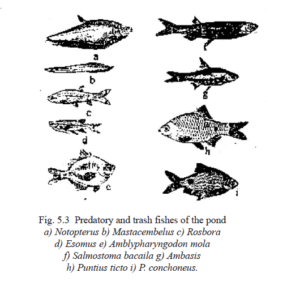
En cualquier estanque Todos los peces de basura y depredadores deben eliminarse antes de sembrar el estanque. Los métodos simples de drenar y secar los estanques y luego ararlos son los más efectivos para controlarlos. Si el drenaje no es posible, el estanque lo más completo posible, los peces indeseables deben eliminarse de los estanques mediante redes de arrastre repetidas. Sin embargo, muchos peces escapan de la red permaneciendo en los bordes del estanque. Los moradores del fondo, como murrel, perchas de escalada, magur, singhi, etc., que se entierran en el barro son difíciles de atrapar con redes. La deshidratación es el mejor método, donde el agua debe eliminarse mediante bombeo, aunque este es un método antieconómico. En este caso, la mejor manera de deshacerse de los peces indeseables es envenenar el agua de un estanque que no se puede drenar.
Hay varios tipos de venenos para pescado disponibles en el mercado. Estos se clasifican en 3 grupos:hidrocarburos clorados, organofosforados y derivados vegetales. Los hidrocarburos clorados son los más tóxicos para los peces. Estos se acumulan en los tejidos de los peces y son compuestos estables, que no se metabolizan. Los organofosforados son menos tóxicos para los peces, pero tienen efectos adversos sobre la flora y fauna acuáticas. La acumulación es menor en los tejidos de los peces y relativamente menos persistente en el agua. Por eso, los derivados de plantas son buenos venenos para peces.
Los mejores venenos naturales son la torta de aceite de mahua, rotenona de raíz de derris, cal viva (160 kg / ha), torta de semillas de té (150 kg / ha), torta de semillas de camelia (50 a 200 kg / ha dependiendo de la profundidad del agua), desperdicios de tabaco (150-200 kg / ha) y semillas de algodón en polvo (Cuadro 6.1). Otro químico seguro es la saponina, que es un compuesto de torta de semillas de té y se aplica a una dosis de 0.5 ppm en el estanque. La mayoría de los venenos naturales se degradarán y desaparecerán del agua en 7-12 días. Mahua (Mahuca latifolia) la torta de aceite es un excelente veneno, que se descompone después de 10 días y es útil como fertilizante. Los productos químicos como la endrina La dialdrina y el DDT deben evitarse en estanques, ya que pueden durar años en el suelo y luego matar a todos los peces del estanque.
La erradicación de insectos acuáticos (Fig. 5.4) se analiza en el manejo de estanques de cría.
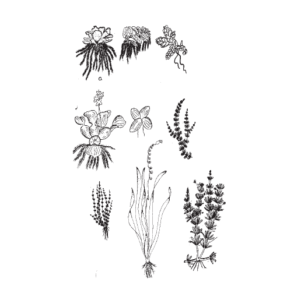
Higo. 5.4 Acuático insectos
- a ) mi r mi t mi s B ) PAG mi s C decir ah t I tu s C ) D I norte mi tu t mi s D ) La C C o pag h I l tu s mi ) S t mi metro o l o pag h tu s F ) R h a norte t a I C tu s gramo) Limnometra h) Anisops I) Diplonychus j) Regimbartia k) Notonecta l) Hyphoporus metro) Laccotrephes norte) Cybister o) Lithocerus pag) Hydrophilus q) Ranatra r) Hydaticus s) Sandracott
Encalado :
La cal se aplica con frecuencia en las prácticas de acuicultura para mejorar la calidad del agua. Después de arar el estanque, aclarado y alisado, debe acondicionarse con lima. El encalado aumenta la productividad de un estanque y mejora el saneamiento. Es tanto profiláctico como teuráptico. Los principales usos de la cal son;

Higo. 5.5 Acuático malas hierbas
- a) Pistia B) C) Azolla D) Eichhornia mi) Lemna F) Ceratophyllum gramo) Chara
a) Naturalizar la acidez del suelo y el agua.
b) Incrementar el contenido de carbonatos y bicarbonatos en el agua.
c) Contrarrestar los efectos venenosos del exceso de Mg, Iones K y Na.
d) Mata las bacterias, parásitos de los peces y sus etapas de desarrollo.
e) Acumula reserva alcalina y detiene eficazmente las fluctuaciones de pH gracias a su acción amortiguadora.
f) Neutraliza los compuestos de Fe, que son indeseables para la biota de estanques.
g) Mejorar la calidad del suelo del estanque promoviendo la mineralización.
h) Precipita el exceso de materia orgánica disuelta y esto reduce las posibilidades de agotamiento del oxígeno.
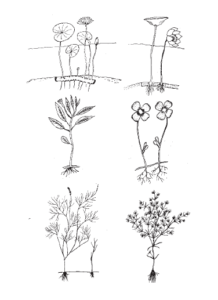
Higo. 5,6 Acuático malas hierbas
a) Nymphaea B) Nelumba C) Jussiaea D) Marsilia mi) Potamogeton F) Najas
i) Actúa como desinfectante general de estanques para el mantenimiento de la higiene del estanque.
j) La presencia de Ca en la cal acelera la composición de la materia orgánica y libera CO2 del sedimento del fondo.
k) La cal hace que el K no esté disponible para las algas.
Los estanques nuevos se pueden encalar antes de que se llenen de agua. La piedra caliza debe esparcirse uniformemente sobre el fondo seco del estanque. En estanques con agua, es mejor esparcir uniformemente sobre la superficie del agua. Si el estanque es nuevo o viejo, Se debe colocar una capa de cal en el fondo del estanque. La cal se debe agregar al estanque dos semanas antes de bombear el agua al estanque. El mejor momento para la aplicación de la cal es durante el período en que se ha detenido la fertilización. No se debe aplicar cal mientras se fertiliza el estanque.
Los suelos altamente ácidos (pH 4-4,5) necesitan una dosis de 1000 kg / ha de cal, mientras que los suelos ligeramente ácidos (pH 5,5-6,5) necesitan unos 500 kg / ha de cal. Los suelos casi neutros (pH de 6,5 a 7,5) requieren solo 200-250 kg / ha de cal. El pH del suelo del estanque debe llevarse a un nivel casi neutro para obtener los máximos beneficios.
W a eri norte gramo :
Después de que la cal se haya aplicado al fondo del estanque durante al menos dos semanas, el agua debe dejarse entrar lentamente. El agua debe caer desde la entrada de agua al estanque, para que el agua se mezcle con el oxígeno del aire al caer al estanque. El agua no debe entrar al estanque demasiado rápido. Si el agua entra demasiado rápido, el fondo del estanque se agitará y, por lo tanto, se enlodará el agua. Las pantallas deben usarse en las entradas, para que los peces y otros organismos no deseados no entren en el estanque. Debe dejarse libre el estanque durante unos días después de que se haya llenado. Debe comprobarse la calidad del agua del estanque antes de que se suelten los peces.
Mamá norte tu I ng :
Los peces requieren ciertos elementos para crecer y reproducirse. Estos elementos son C, H2, O2, N2, K, PAG, S, Ca y Mg. Algunos otros elementos, llamados oligoelementos como Cu, Zn, Minnesota, Mes, B, etc., se necesitan solo en pequeñas cantidades. Si estos elementos faltan o están presentes en cantidades muy bajas, el pez no crecerá bien. Los peces obtienen estos elementos del suelo del estanque, el agua del estanque y la comida que comen. Algunos estanques de peces carecen de elementos necesarios para el crecimiento y la productividad de los peces. En estos casos, es necesario agregar fertilizantes al agua. Los fertilizantes son materiales simples que contienen los elementos faltantes. Los elementos que faltan o escasean con mayor frecuencia en los estanques de peces son el N2, P y K. Los fertilizantes que consisten en estos elementos faltantes se agregan al estanque de peces para ayudar al crecimiento de los peces y del plancton. que los peces usan como alimento.
Un estanque rico en fitoplancton suele ser de color verde brillante. El color indica una floración de algas. En una floración normal el disco secchi desaparece a unos 30 cm de profundidad; cuando el disco secchi desaparece a 20-40 cm de profundidad, el estanque es muy productivo y fértil. No se necesita fertilizante en un estanque en estas condiciones.
A veces, un estanque puede volverse demasiado fértil. Si el disco secchi desaparece a solo 15 cm, la flor es demasiado espesa. La gruesa capa de verde bloquea la luz del sol en el estanque y el fitoplancton no puede liberar oxígeno. En este caso, hay demasiado fertilizante en el estanque, y, por lo tanto, debe eliminarse parte de la capa gruesa de algas formada en la superficie del agua. Estos estanques no necesitan fertilizantes.
Si el disco secchi todavía se puede ver a 43 cm de profundidad, el plancton del estanque no es suficiente. Está, por lo tanto, necesario agregar fertilizante al agua del estanque para preparar un estanque fértil. Otro factor que determina la necesidad de fertilizantes es la calidad del suelo. Si el suelo es muy productivo, la necesidad de fertilizantes es menor; si el suelo no es tan productivo, la necesidad de fertilizantes es mayor.
La elección de los fertilizantes se puede decidir sobre la base de la composición física del suelo. En suelos franco arenosos o arenosos con escasa materia orgánica, fertilization is carried out with organic manures. In loamy soils with medium organic matter, a combination of both organic and inorganic fertilizer should be applied. In highly clay soil with rich organic matter, fertilization is carried out with only inorganic fertilizers. Amount of fertilizers to be applied to ponds may be worked out on the basis of the productive potentiality of the pond. The ponds can be categorised on the basis of N, PAG, organic carbon and alkalinity (Table 5.1).
In case of deficiency of potash, it can be included at the rate of 25-50 kg/ha/yr. The NP ratio should be 2:1. Además, cow dung may be applied at a rate of 10, 000-15, 000 kg/ha/yr. The best way to use this
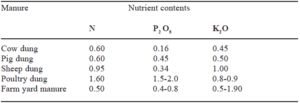
animal manure is to make a soup of it in a tank by mixing it with water. This soup should be spread in the pond. Fertilizer should be applied at a rate determined by the area of pond. Area is the length of the pond, multiplied by the width. Por ejemplo, if a pond measures 20 m in length and 10 m in width, it has an area of 200 square metres (m2). This is equivalent to 2/100 of a hectare. To fertilize a 200 m2 fish pond with cow dung, at the rate of 1000 kg/ha, you must use only 20 kg.
Fertilization should be done 2 weeks prior to stocking the fish, so that, sufficient natural food is available in the pond. 1/5 of the total quantity of organic manure is required as an initial dose, and the rest is applied in 10 equal instalments. Organic and inorganic fertilizers may preferably be applied alternating with each other in fortnightly instalments. The amount of fertilizers required in general for fish ponds is 10, 000 kg/ha/yr of cow dung, 250 kg/ha/yr of urea, 150 kg/ha/yr of single superphosphate and 40 kg/ha/yr of murate potash. In large ponds, fertilizers may be applied by using boats.
S t o ckin gramo
Stocking is used to describe the act of placing the fish into the pond. The stocking density is used to describe the total number of fishes, which can be stocked in a pond. The stocking ponds are generally stocked with fingerlings which are about 75-100 mm in size. For increasing fish production, the selection of fish with desirable qualities is the most important biological factor. Since fish with the shortest food chain give the highest production, phytophagous, herbivores, omnivores and detritus feeders are preferred for culture in stocking ponds. For rearing of fish, either monoculture or polyculture in any species, combination may be carried out, most preferably the polyculture. The desirable stocking rate is 5, 000 fishes per hectare. In a monoculture pond, the stocking rate is the same as the stocking density because there is only one kind of fish. There is enough food and room in a pond for a particular number of fish. Good growth of fish depends upon the right number of fish cultured in the pond.
The stocking rate depends on the volume of the water and on the oxygen balance of the pond rather than the size of the pond. The ratio of fish to the volume of water should not be less than 1 fish to 2 m3 of water where there is no forced aeration.
As far as possible each pond should be stocked with silver carp and catla, the surface feeders. This should not be more than 30 to 35%, otherwise it would affect their growth adversely. Rohu is a column feeder and it should not be stocked more than 15-20%. Bottom feeders such as mrigal and common carp together can be stocked to the extent of 45%. Availability of aquatic weeds in the pond decides the stocking density of grass carp. It should preferably be about 5-10%.
Rearing of fingerlings to table-size fish may continue for one year or only 6 months. In the latter case, the stocking density may be reduced. En este sistema, harvesting is done monthly and the number and species of harvested fish are replenished with a new stock of fingerlings. This is possible only where the supply of fingerlings is available throughout the year. Under these conditions the production is much higher than with the annual or 6 monthly stocking and harvesting.
In a polyculture of Chinese carp, the stocking density is about 20, 000 fingerlings per hectare. The stocking rates are 5, 000 grass carp, 5, 000 bighead carp and 10, 000 silver carp. If common carp is also included, then in a stocking density of 7 Chinese carps, 2 fish would be grass carp, 3 would be common carp, and there would be only one each of bighead and silver carp. In Malaysia, the ratio of carp stocking has been suggested at 2:1:1:3 for grass carp, bighead, silver carp and common carp.
If fishes are stocked in a pond, there should be enough oxygen, no temperature difference between the stocking water and the pond water. When the fingerlings are transported from a far away place, in order not to stress the fish, the bags with fingerlings are placed in the pond unopened until the water temperature inside the bags is about the same as the temperature in the pond. When it is same, the fingerlings are allowed to swim out of the container into the pond water by themselves. The fingerlings should not be poured into the pond water, as they die because of the shock of hitting the water.
Pos t -stock I norte gramo administrar metro en t
W a te r como l eso y Hombre a joya mi norte t
Water quality managment is discussed in detailed
F mi mi D Mana gramo eme norte t
The feed management is discussed in detailed in chapter 6.
Heal t h Managemen t
The health managment is discussed in detailed in chapter 7
Harv mi stin gramo
The fishes are harvested after a one year with the help of gill nets. Five to Six fisherman depending up on the size of the pond enter into the pond from one side, move to wards the other end with gill net and catch the fishes.
Acuático malas hierbas y su controle
Aquatic vegetation is described as aquatic weeds. Any undesirable vegetation which causes direct or indirect damage to the fishes or hamper the fishery operations may be described as weeds. In the tropical regions of the world, aquatic weeds grow luxuriantly causing nuisence to fisheries, water transportation and water supply systems, and provide conducive habitat for factors of several diseases. En India, ponds and tanks usually have fertile soil and water and so they invariably overgrow with all types of aquatic vegetation. For successful farm management, a strict watch on the growth of unwanted vegetation is necessary. With the presence of excess vegetation it becomes very difficult to net fishes in weed infested ponds.
Rea s sobre s fo r C ont rol o F hierba s
Uncontrolled vegetation growing excessively hinder fisheries interest in many ways. The weeds in the water reduce the yield of fish just as the weeds in the field reduce the yield of cultivated crop. It is necessary to control the weeds in fish ponds. Some of the reasons for this are quite obvious.
1. Due to the presence of aquatic weeds in the pond, the fishes cannot swim properly, thus restricting their ability to browse and hunt for food.
2. Weeds absorb nutrients for their growth and multiplication, thus absorbing nutrients essential for planktonic food of fishes which causes depletion offish food. Due to their presence, water loses its fertility to sustain fish stock.
3. Weeds offer shelter to unwanted predatory and weed fish, which hunt upon or compete with the cultivated varieties.
4. By profuse growth, weeds choke the entire water column, restrict netting and make navigation impossible.
5. The presence of weeds in water reduces the water holding capacity of the area and water loss due to evaporation through leaves occurs. In case of few weeds, the evaporation is much more than that from the open surface.
6. Weeds cause wide dirunal fluctuation in dissolved oxygen, temperature and other physico-chemical parameters to make the water inhospitable for fishes.
7. The weeds accelerate the process of siltation of the water area, ultimately turning it into a swamp.
8. Weeds harbour harmful insects, frogs, snakes and other predators enabling them to breed and multiply.
9. Weeds choke the gills of the tender young fishes.
10. The weeds interfere with the circulation and aeration of water, restrict the diffusion of sunlight and upset the normal chemical balance of the system.
11. The toxic gases in the pond bottom ooze produced by rotting organic matter cannot be easily eliminated into the atmosphere if the water surface is choked with weeds. In these conditions very few fish could survive in the water.
1 2 . Aquatic weeds are responsible for minimising water depth and ultimately cutting down the soil-water interaction which is so essential for recycling of nutrients for the fishes.
13. Thick algal blooms deplete the oxygen in the water during dark hours or when they die or rot and cause sudden mortality of the fish stock.
14. Some kinds of algae cause allergic irritations on human skin and make it difficult for people to get into the pond.
15. The fish yield is reduced in weedy infested water bodies. 16. Weeds affect water irrigational potential.
A dva norte tage s o F w mi ed s
Weeds do not always have harmful effects. The weed mass can be turned to some productive use which will recoup some of the losses involved in controlling them. The extra advantage of the utilization method lies in producing valuable end products. Different methods of control and utilization of weeds should be seen as useful tools in an integrated system of aquatic weed management. The aquatic weed are advantageous and help in the development and maintenance of a balanced aquatic community. The advantages are:
1. Aquatic weeds produce oxygen during photosynthesis and this oxygen is utilized by the fishes.
2. Weeds provide shelters for small fishes.
3. Weeds provide shade for fishes.
4. Weeds provide additional space for attachment as well as food for aquatic invertebrates which in turn serve as food for fishes.
5. Weeds help in the precipitation of colloidal clays and other suspended matters.
6. Weeds, after removal, can be used as bio-fertilizers and even used in fish farms.
7. Aquatic weeds are used as food for fishes like grass carp.
8. Weeds are also used for pollution abatement.
9. Weeds are used as a source of energy production.
W mi mi D s a s fo o D fo r F es h
There are a number of herbivorous fishes which directly consume aquatic weeds. The grass carp is a fast growing fish that feeds on aquatic weeds. The fish utilize submerged weeds like Hydrilla, Najas, Ceratophyllum, Ottelia, Nechamandra y Vallisnaria in that order of preference. The young fish prefer smaller floating plants like Wolffia. Lemna, Azolla y Spirodela. In composite fish culture the production is greatly enhanced by inclusion of grass carp because of its fast growth. It also occupies an ecological niche, which otherwise remains unfilled with the fear that the grass carp may breed and compete with the native fish population in natural waters, only the triploid grass carp which is supported to sterile is being allowed to be introduced.
The other herbivorous fish which utilize aquatic weeds are Pulchelluspulchellus, Oreochromis y Etroplus. Though an omnivore, Cyprinus carpio feeds well on filamentous algae like Pithophora y Cladophora. The manatee, Trichechus sp., a large air-breathing herbivore, is being utilized for the clearance of aquatic weeds in the canals of Guyana.
These advantages of water plants become negligible when they are present in excess and their control then, is essential. The methods to be adopted to control the aquatic vegetation can be formulated only after the plants are identified.
F a Connecticut o r s C o ntr I bu t en gramo t o pag rofuse gramo rowth
A number of factors either individually or jointly influence favourable growth of weeds in cultivable waters. These are :
1. Climatic condition and geographical situation of the area.
2. Water depth – lesser the depth, more is the growth of vegetation especially the submerged rooted or emergent vegetation.
3. Clarity of water or turbidity – more suspended material adds more turbidity thus retarding penetration of light in the pond which has an effect on the growth of vegetation.
4. Silt deposition at the bottom, promotes excessive growth of aquatic weeds.
5. Quality of water – fertile condition of water has its impact on the propagation of vegetation.
6. Infestation from other sources – the minute generative vegetative components like spores and cysts may be carried through the water supply, viento, inundación, aves, vacas, etc.
T y Educación física s o F aq tu a I C pequeñito D s
The aquatic weeds (Fig. 5.5 and 5.6) are classified on the basis of habitat of plants – rooted weeds and floating weeds.
R o ot mi D w ee D s
1. Bottom rooted weeds :Plants are rooted at the bottom of the water body and spread within the bottom layers of water. Vallisneria, Ottelia
2. Submerged rooted weeds :The plants are rooted in the bottom soil on the deeper margins of the pond and ramifying in the volume of water. p.ej. Hydrilla, Chara, Potamogeton
3. Marginal rooted weeds :Plants are rooted on the marginal region of the surface layer of water and ramify on the surface of water and also on the adjoining land. p.ej. Marsilia, Ipomoea, Jussiaea
4. Plants are marginally rooted and ramifying within the marginal region of the water volume. P.ej. Typha, Scirpus, Cyperus, Panium
5. Emergent rooted weeds :Surface plants which are rooted in the bottom of the pond but their leaves float on the water surface or rise above the water level. They prefer shallow parts and shores of the pond. gramo. Nymphea (Lotus), Nymphoides, Nelumbium .
Flo a estaño gramo hierba s
1. Surface floating weeds :The plants are floating on the surface of water and with roots in the water. p.ej. Eichhornia (water hyacinth), Pistia, Lemma, Azolla, Spirodele . Few surface plants, are floating on water but without roots g. Wolffia .
2. Submerged floating weeds :The plants are floating but submerged in the water e.g. Ceratophyllum, Utricularia .
3. We can also divide the aquatic weeds broadly as floating, emergent, submerged, marginal weeds and algal blooms and filamentous algae.
Metanfetamina o D s o F pequeñito D co norte t rol
Based on the intensity of infestation and type of weeds, the aquatic weeds can be controlled by means of manual, chemical and biological methods.
a . METRO un tu a l a norte D me C han I California l me t Ho D
When infestation is scanty and scattered, the weeds can be controlled manually only in small water bodies. This is an ancient method and is still practiced in most of the places. The pre-monsoon period (April-May) is more suitable for manual removal. In many parts of the country, advantage is taken of the drought to control the weeds as ponds and other water bodies dry up or register a sharp fall in the water area, and the plants can thus be removed. Where labour is cheap, manual labour is often employed to remove aquatic weeds. The weeds are controlled manually by hand picking, uprooting the emergent and marginal weeds and cutting the others with scythes.
Most of the floating plants like Pistia, Lemna, Azolla, Wolfia y Eichhornia can be effectively controlled by clearing manually with nets, mientras que, the marginal weeds like grass, sedges, rushes, Typha , etc. may be controlled by repeated cutting. This method does not inflict any pollution and there remains no residual toxic effect as in the case of chemical treatment or shading. The weeds thus collected should be dumped far away, be converted into compost manure or burnt so as to have no chance of reinfestation.
Manual weed control is very expensive, time consuming and unsatisfactory. Por lo tanto, mechanical devices have been developed. Cleaning of a weed infested water sheet through the mechanical method, becomes necessary where the water area is not shallow enough to walk through or small enough to uproot the weeds manually or cut them effectively with simple hand implements. Labour problem and an urgency of the work to eradicate the whole area of weeds within a stipulated time period before water level is raised, are the other factors which make it necessary to resort to mechanical methods for eradication of weeds.
A number of devices ranging from very simple barbed wire bottom rakers to sophisticated mechanical equipments like power winches with steel wire, under-water cutter, dredgers, mechanised removers, etc. are in vogue to use for the purpose. Broomfork, long fork, sickels or scythes, long knives, barbed wire netting, chaining and motor powered weed cutters are some of the specialised equipment used for this purpose.
Crusher boats are used to clear water bodies infested with water hyacinth. The rooted submerged weeds are dislodged mechanically by dragging with log weeders fitted with spikes and barbed wires. Mechanical winches are used for cutting and dragging of submerged weeds.
Another simple method of control of water hyacinth is to construct floating barriers which prevent water hyacinth from reaching other water bodies. The floating barriers reduce time, labour and cost as the accumulated weed is removed by draglines.
Laser rays are also used to control water hyacinth, usually of 10.6 nm wavelength. The irradiated plants are plasmolysed immediately.
Burning follows in proportion with the amount of laser energy applied. Many of the plants die within ten weeks. Daughter plants are stunted and turned pale due to destruction of chlorophyll.
C hemic a l C o ntrol :
A large number of chemical weedicides are used for control of aquatic weeds. It is a very effective and cheap method. The weedicide is to be selected in such a way that it should be cheap and easily available, non-toxic to fish and man, should not pollute the water and should not involve the use of special and costly equipment. The lethal action of the weedicide is either by direct contact or by translocation of chemicals from the treated part of the plant to the other areas of its system resulting in both cases in the death of the plant.
Different type of chemicals are in use for eradication of weeds. Many of these are poisonous, toxic or harmful for human and other animals. Their mode of action on the weeds are also different. The same chemicals may not be useful for the eradication of different types of weeds.
Chemicals used for eradication of weeds are broadly classified under three categories.
1. Compounds of heavy metals. p.ej. Copper sulphate, Sodium arsenate, etc.
2. Hormone weedicides g.2, 4-D, 2, 4, 5-T, etc.
3. Fertilizers. gramo. Superphosphate, Urea, Ammonia, etc.
According to the mode of action, a weed killer chemical can also be grouped into two categories.
1. Contact weedicides – which kill plants on contact.
2. Translocated weedicides – which are absorbed by plants and are killed.
The contact weedicides may be selective or non-selective killer types. The selective killer type of chemicals are effective only on some specific weeds whereas the non-selective type chemicals kill all types of weeds. Besides weedicides, some chemicals are used as soil sterilants. It shows that all chemicals are not suitable for killing all types of weeds and all the chemicals may not have all the qualities required for commercial use. Some chemicals are extremely poisonous for animals and human beings. Some chemicals like fertilizers are required to be applied at a very high dose which is neither economical not easy to apply. Endothal, Endothal amine salt, 2, 4-D are toxic to fish. Diquot is toxic to fish and not advocated to apply in muddy water.
Biolo gramo ica l estafa t rol :
Of all the weed controlling measures, biological control of weeds through stocking the water with weed-eating fish, such as grass carp, Ctenopharyngodon idella, is found to be an effective and satisfactory method. Grass carp is a voracious weed eater and possesses strong pharyngeal teeth, which enables it to grasp and nibble at soft weeds like Hydrilla. The nature of its gill rakers helps it to sieve large quantity of microvegetation from the water body. Because of its efficiency for weed consumption and convertibility into flesh it is preferred for stocking in weed infested waters.
Grass carp usually eat the soft parts of the aquatic plants leaving behind the harder parts like stem. It shows a certain preference for soft submerged weeds like Hydrilla , Ceratophyllum , Najas , Vallisneria . Its lower preference towards Ipomea is due to the hard nature of the weed. Hydrilla verticellata is the most preferred as it has soft leaves which could be easily nibbled and are easily digested.
Control of weeds, especially the soft submerged type of weeds, through biological control by stocking the water with grass carp has certain advantages. It is not only the most economical due to its low cost of operation and easy application but also does not contaminate the water with toxic substances unlike chemicals used for control. Es más, it gives economical returns by increased fish production.
Common carp, Cyprinus carpio and Katti, Acrossocheilus hexagonalepsis and ducks are also used for biological control of aquatic weeds. Beatles and stemborers are also recommended for the purpose.
Biological control of weeds may be done by shading. Increasing turbidity, covering the surface by controllable floating weeds, shading the water area by canvas or coloured polythene sheets to cut down sunlight in order to check excessive growth and vegetation are some of the methods also in use.
Whichever method is used for the control of aquatic weeds, employment of manual labour is necessary. In the mechanical method labour is necessary for the clearance of the remains of the vegetative parts of the weeds. Even if the chemical method is resorted to, the dead weeds which sink to the bottom have to be removed. A rational utilization of all methods suitable according to the local condition and also economical is to be resorted to for eradication of weeds. Sin embargo, checking of excessive weed growth at the proper time is also one of the effective and important factors to keep the weed under control. Control measures should be adopted before the flowering season of the weeds. The time for control of weeds given below has been found to be appropriate under Indian conditions.
January-February March-May
June-July July-August
August-September October-November
- Eichhornia, lotus – Duck weeds
- Utricularia, Ottelia - Jussiacea, Trapa,
norte ymphoides , PAG istia , Nechamendra
- Najas, Myriophyllum - Scrispus, Nymphaea
W a te r Quali t y METRO anageme norte t
Successful pond culture operations mainly depend on maintenance of a healthy aquatic environment and production of sufficient fish food organisms in ponds. Water is the primary requisite to support aquatic life. Physical, chemical and biological factors play an important role in governing the production of fish food organisms and fish production in the pond. Water not only plays an important role in the fish production, but also it helps in the survival and growth of the fish. Por eso, fish farmers should take a lot of care to maintain hygienic conditions in the pond, so that they get more profits. If the water quality is maintained with utmost care, the farmers need not spend much money for curing the diseases. If the water quality is maintained, the fishes also have a good taste. Water quality is influenced by physical, chemical and biological factors.
Physic a l factor s
The physical condition of water is greatly influenced with depth, temperatura, turbidity, light and water colour.
W a t mi r departamento h
Pond depth has a vital bearing on the water quality. Depth determines the temperature, the circulation pattern of water and the extent of photosynthetic activity. In shallow ponds, sunlight penetration upto the pond bottom and facilitates an increase in the productivity. A depth of 1-2 metres is considered optimal for biological productivity of a pond. If the depth is very less, water gets overheated and thus has an adverse effect on the survival of the fish.
W a te r temperatura mi ratur mi
Temperature affects fish migration, reproduction and distribution. It depends on climate, sunlight and depth of the pond. Temperature varies vertically in the water body and also shows diurnal fluctuations. Fish posses well defined limits of temperature tolerance with the optimal being 20-32°C. Indian major carps can thrive well in the temperature range of 18-38°C. Wide fluctuations of water temperatures affect the survival of fish. In very low or very high temperatures, the fishes are strained, spend more energy and growth of the fish is affected. These temperatures also affect the chromatophores of prawns, and the prawns develop a red colour. If the temperature is maintained optimally, the red colour disappears. At low temperatures the food consumption offish and prawns decreases and gasses are produced at high temperatures. Por eso, water temperature maintenance is very essential to obtain high yields. Fish and prawns or their seed have to be acclimatized whenever they are transferred from one pond to the other.
T tu rbi D eso y
Water turbidity is mainly due to suspended inorganic substances like clay, silt, phyto – and zooplankton and sand grains. Ponds with a clay bottom are likely to have high turbidity. Turbidity reduces sunlight penetration and photosynthesis and hence acts as a limiting factor. If the turbidity is due to more suspended particles, they absorb nutrients in their ionic form, making them unavailable for plankton production. High turbidity also reduces the dissolved oxygen in the pond water. Turbidity is measured with the secchi disc. If the secchi disc disappears at 30-50 cm. the water is productive in nature. If it is not visible at a depth less than 25 cm, a dissolved oxygen problem could anse during the night. If it is more than 50 cm, the plankton produced is less in the pond water. In less turbid waters, the aquatic weeds growth is more. In highly turbid waters, the sand grains accumulate in the gills of the fish and prawns, causing suffocation and excessive secretion of mucous. High turbidity can be reduced by adding lime and alum. If the water is more turbid, it should be stored in sedimentation tanks and then used for fish culture. If the turbidity is more due to phytoplankton, water m the pond should be changed. Fertilizers have no effect in high turbid waters, hence fertilization of the pond should be stopped.
L I gh t
Availability of light energy to a fish pond greatly influences its productivity and photosynthesis. In shallow ponds, light penetrates to the bottom and is responsible for luxuriant growth of aquatic weeds. In high turbid waters, the light will not penetrate to the bottom. Debido a esto, the vegetation at the bottom will decay and produce harmful gasses, which affect the fish and prawn life.
W a mi r C o lou r
Water gets its colour due to phytoplankton, zooplancton, sand particles, organic particles and metallic ions. Water used for fish or prawn culture should be clear, either colourless or light green or blue in colour. Water colour is golden or yellow brown if diatoms are more. This type of water is best for prawn culture. Brownish green, yellowish green and light green coloured waters are also good for prawn culture. Water becomes greenish in colour when phytoplankton is more, develops a brown colour due to zooplankton and mud colour due to more sand grains. Water with black, blackish green, dark brown, red, yellow colours are not good for culture. These colours are due to the presence of more phytoplankton, bad pond bottom and acids in the water. The red colour of water is due to the presence of high levels of iron and death of phytoplankton (phytoerythrin released).
Chemica l fac t o s
The chemical factors like pH, oxígeno disuelto, alkalinity, hardness, phosphates and nitrates influence the productivity of the pond.
pag H
pH is the hydrogen ion concentration, which ranges from 0-14. Water is slightly alkaline in condition, with the optimal range of 6.5-8. Less than 5 and more than 10 pH is lethal to fish and prawns. The pH of pond water undergoes a diurnal change, it is alkaline during the day time and slightly acidic just before day break. The fluctuations of pH are similar to dissolved oxygen. pH fluctuations are more in phytoplankton and weed infested waters and water with less hardness. No sudden pH fluctuations in brackish water and sea water occurs due to their buffering capacity.The difference in pH from morning to evening should not be more than 0.5. When pH increases, ammonia and nitrites become toxic, when it is reverse H, S becomes more toxic. pH below 6.5 and above 8.5 is responsible for reduction of growth and resistance of parasitic infection increases in acidic waters. Whenever pH falls, lime should be added to the pond water. When pH is high, lime should not be used. Urea should not be used to reduce pH. This is because NH3 becomes toxic at high pH. It is always better to add new water to maintain an optimal pH. Alum or aluminum sulphate can be used to reduce the pH and turbidity. Alum removes phenolphthalin alkalinity. 1 ppm alum reduces 1 ppm phenolphtahlin alkalinity. Pez, prawns and their seed should be acclimatized to new water whenever they are transferred from one pond to another.
Di s resolver D oxyge norte
Dissolved oxygen is one of the most important chemical parameters, which has a great influence on the survival and growth of fishes and prawns. The pond water gets oxygen mainly through interaction of atmospheric air on the surface water of the pond and by photosynthesis. It is produced only during daytime, reaches a maximum at 3 PM, then gradually decreases upto early morning. During the night it decreases and it reaches a minimum during the early hours. It is due to nil production of dissolved oxygen at night and instead, consumption of oxygen by plankton, weeds, fishes and prawns. During overcast days, the production of dissolved oxygen during the day is less and during the subsequent nights it decreases drastically. Cuando la temperatura del agua aumenta, oxygen is released into atmosphere. When salinity increases it is dissolved in water. The optimum dissolved oxygen is 5-8 ppm. If less than 5 ppm the growth rate decreases the fish and prawns are prone to get diseases and less than Ippm of dissolved oxygen results in death. More than 15 ppm results in gas bubble disease in fishes and prawns. Whenever the animals are under stress due to less dissolved oxygen the food consumption temporarily decreases. When oxygen decreases, prawns accumulate on the water surface and near the pond shores and are found stationary at one place or show weak movements. Fishes come to the surface and engulf the air. Prawns get milky white spots when dissolved oxygen is continuously less. It decreases gradually from the surface to the pond bottom and CO, , NH3 and other gases increases, hence prawns are under more stress. Farmers should take precautionary measures at nights, especially during the early hours to increase oxygen levels. If it is very less, the water surface should be disturbed by beating water with bamboo poles or by rumming boats or by using aerators.
Alkalinit y
Alkalinity is caused by carbonates and bicarbonates or hydroxides of Ca, Mg, Na, K, NH4 and Fe. Alkalinity is less in acidic soils and in ponds with more organic load. Alkalinity is more in clay soil ponds and is increased if water is pot exchanged. The optimal level of total alkalinity is 40-150 ppm. Alkalinity has direct effect on the production of plankton. "
H Arkansas D nordeste s s
Hardness is caused by Ca and Mg. Water with less than 40 ppm is soft and more than 40 ppm is hard water/ The pond water with a hardness of 15 ppm or more is satisfactory for growth of fishes and prawns and do not require additional lime. If water has less than 11 ppm hardness it requires liming for higher production. If it is less than 5 ppm, the growth rate is affected and causes eventual death of the fish.
S alin I t y
Na, C12, California, Mg, K, bicarbonates and sulphates are responsible for salinity of the water. Salinity is an important parameter for survival, growth and high production in brackishwater culture systems. Salinity ranges between 0-40 ppt in brackishxvater and 35 ppt in sea water. The optimal salinity for prawn culture is 15-20 ppt. The prawns can survive at 2 ppt and 40 ppt. but their growth rate decreases. If the salinity is high, the water should be exchanged. Due to heavy rains more freshwater enters into the ponds and sudden decrease is found in salinity levels which affect the life in the pond. To avoid this, two outlets (one at high level and other at low level) should be provided to send out freshwater and sea water separately from the pond. The animals should be acclimatised before introducing them into new water.
California r bo norte dio X identificación mi
CO, is produced during respiration and consumed during photosynthesis. CO, is less during daytime and more at nights. The optimal level of CO, is 5 ppm. At high CO, levels, pH decreases, CO, is accumulated in the blood of the animals and water becomes acidic. The animals become sluggish, loss of resistance occurs, they cannot utilize dissolved oxygen and they ultimately die. Whenever CO, increases lime should be added to the pond. 1 ppm of lime reduces 0.9 ppm of CO, .
Di s Sol v mi D amm o ni a un D I t s C o mpo tu Dakota del Norte s
NH3 is found in excreta and is also released due to decomposition of organic matter. It is an important compound influencing the growth of phytoplankton in the aquatic ecosystem. The optimal limit of NH3 is 0.3-1.3 ppm and less than 0.1 ppm is unproductive. Whenever NH3 increases pH also increases, but dissolved oxygen decreases. CO2 reduces the toxic effect of NH3. NH3 also increases with feed due to high protein levels and death of phytoplankton. When NH3 is more in water, animals may not get excreta with NH3. NH, accumulates in the blood and oxygen transport in the blood reduces. – Gills become black, biochemical tissue is damaged and gasous exchange is affected. NH3 levels can be reduced with good management like no excess feed, optimal stocking and water exchange. Lime should not be added when NH, is high. Optimal level of nitrites is 3.5 ppm.
Hydr o ge norte sulp h identificación mi
H2S is produced in anaerobic conditions by the action of-micro-organisms on sulphur compounds. H S is toxic to fish and prawn. It should be less than 0.05 ppm in pond water. H2S is responsible for respiratory problems. When H, S increases, lime should be added.
B I ologi C a l hecho o r s
The biological factors like plankton, weeds and disease causing agents also play a role in water quality maintenance.
Plan k tonelada - agua r qu a iluminado y
Plankton are free living smaller plants and animals, which move along with the waves. Plankton are natural fish food organisms, which consists of 60% easily digestible proteins. Phytoplankton produce food and O, by photosynthesis. Plankton density variations depend upon the fertilizers used and fish species cultured. Carbon, oxígeno, H , PAG, N, , S, Fe, K, Na, Minnesota, Mes, Zn, B and Cl, are essential for plankton production. Out of these, N, PAG, K, are most important elements for plankton production.
To increase plankton production, organic and inorganic fertilizers should be used. Lime is also essential for plankton production. Fertilizers and lime should be used at regular intervals. This helps in production of plankton in sufficient quantities. Excess production of plankton, especially myxophyceae members settle on the water surface and form algal blooms. This hampers photosynthesis and oxygen depletion is observed, esp£Cially during nights. CO, levels increase in the pond and affect water quality.
Disea s mi cau s en gramo a gramo ent s - agua r cualidad y
The most important aspect of water quality management in the culture system is to maintain fish without disease causing agents and under hygienic conditions. The diseases in fishes and prawns are caused by bacteria, virus, fungi, protozoa, helminth, and crustacean parasites. These parasites enter into the pond along with water, fish or prawn seed and nets from other infected ponds. Due to the unhygienic conditions these parasites cause diseases in fish and prawns, and the fish and prawns become less resistant to diseases. Due to the parasitic infection the growth rate reduces and finally they die. To avoid these bad effects, use good and healthy material and fish and prawns should be examined once in 15 days. Abnormal behaviour offish and prawns is observed in infected ponds. These should be observed and immediate action should be taken, otherwise, whole crop could be wasted / destroyed.
Agua t I C w eed s - w a te r cualidad y
Excess growth of aquatic weeds in fish pond is not a good sign in aquaculture systems. Weeds utilize the nutrients and compete with desirable organisms. Weeds also compete for oxygen, especially during nights and space with fishes. They obstruct the netting operations too. Por eso, the weeds should be removed from ponds by mechanical, chemical or biological methods. Application of lime, fertilizers and feed are some of the important measures to maintain the water quality. These should be applied whenever required. Excess application leads to the poor condition of water quality.
Rol mi o F aer a colina s I norte th mi w a te r qu a iluminado y metro anag mi hombres t
Atmospheric oxygen dissolves in the water at water surface. In this layer, dissolved oxygen increases quickly, but not at the pond bottom./To get oxygen even in the bottom layer, the pond water should be disturbed. To gedhis aerators are very essential. Aerators produce the air bubbles, which disturb the water in the pond, so that more oxygen dissolves in the water.Aerators, therefore play a vital role in aquaculture to increase fish and prawn production.
Different types of aerators are in operation to increase aeration in the ponds. Diffused, air lift pumps, U-tube and splashers are some of the common aerators (Fig 5.7) in operation in aquaculture.
In diffused type, the blower or compressor is arranged on the dyke, and this is connected to a porous tube, which is arranged on the pond bottom. Compressor produces air, which comes out of the porous tube in the form of air bubbles and disturbs the water to produce more dissolved oxygen. The capacity of the aerator depends upon the compressor energy and pond depth.
In air lift pump aerator, air is sent into a tube, which opens on surface of the water. Air bubbles travel through the tube and enhances the dissolved oxygen. This aerated water falls on water surface and increases dissolved oxygen water further.
In U-tube aerator, the U-tube has 12-18 metres depth. At one end. air is pumped with the help of blower and the air bubbles travel to the other end i.e., air bubbles have more contact time with water. These aerators are more efficient, but need more expenditure for construction. Splasher type of aerators are also known as surface aerators. Propeller of the aerator is arranged near the water surface and water is sprinkled which helps in enhancing the oxygen in the pond. Paddle wheel surface aerators are also used in fish ponds. Sprinklers are used in fish ponds where porous pipes are arranged on the water surface and pump the air is pumped with engines into the pipes. This gives good aeration in the pond and produces successful results (such as those obtained in Kolleru area).
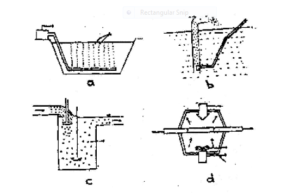
a) Diffused type b) Air lift type c) U-tube type d) Splasher type
Rol mi o F F I lter s I norte th mi Wat mi r como l eso y metro a rocín mi hombres t
Aquatic culture systems contain living organisms in water.These organisms require inputs, such as food and they excrete other materials. The inputs must be mixed with or dissolved in water to be available to the organisms, whose outputs will also become mixed with or dissolved in water. Excessive output and/or input can become toxic if the concentration is allowed to increase in the culture water. The process of removing excess materials is called filtration. It consists of passing the water through a thick layer of sand and gravel which act as strainers. Suspended and colloidal matter in the water and also a large number of bacteria are caught in the interstices of the sand during its passage. The mechanical, biological and airlift filters are generally adopted in aquaculture practices to manage and control the water quality for intensive rearing and culture.
Mechan I California l filt mi r
A mechanical filter (Fig 5.8 a) is an under drained water tight basin in which the filtering materials are placed. The size of a mechanical slow sand filter unit may be about 30 to 60 m x 15 to 30 m or more and about 2.5 m to 3.5 m deep according to desired flow. Water after passing through the filter is collected in an outlet chamber, which is equipped with a flow regulating arrangement. The filtering material about 90 cm to 150 cm of which about 60 cm to 90 cm is fine sand, is laid on top of the under drainage system in five or six layers in progressively smaller sizes towards the top.
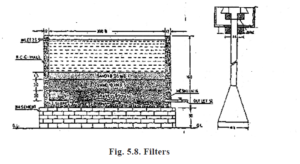
a) Mechanical filter b) Airlift filter.
The sand is supported on two or three layers of graded gravel, with the finest layer immediately below the sand and the coarsest material at the bottom of the filter, packed around the drains. The gravel layers must be graded sufficient to prevent the material from mixing and the sand being drawn down.
The following thickness may be taken for the filtering materials from the bottom towards the top.
1. 10 cm to 15 cm of broken stone 40 mm to 65 mm size
2. 8 cm to 15 cm of gravel 20 mm to 40 mm size
3. 5 cm to 10 cm of gravel 3 mm to 6 mm size
4. 15 cm of coarse sand and
5. 60 cm to 90 cm of fairly uniform fine sand.
When the resistance in the filter (due to sand and clogging) i.e., loss of head, is equal to the total depth of water on the filter, the operation will stop. The loss of head should not be greater than the depth of the filtering sand. When it becomes excessive and before a negative head is formed the filter should be cleaned. The level of the filtered water at the outlet chamber should not be below the level of the surface of the filter sand.
The rate of filtration is 120 litre per minute when the graded layers are 1′ sand of 0.05 to 0.1 mm, 6″ sand of 0.1 to 0.5 mm, 6″ gravel 2 to 5 mm and 1′ metal 5 to 10 mm at the total filtering surface area of 144 square feet.
Biologica l filte r
It comprises the mineralisation of organic nitrogenous compounds, nitrification and dentrification by bacteria suspended in the water and attached to the gravel in the filter bed.
Heterotrophic and autotrophic bacteria are the major groups present in culture systems. Heterotrophic species utilize organic nitrogenous compounds excreted by the animals as energy sources and convert them into simple compounds, such as ammonia. The mineralisation of these organics is the first stage in biological filtration. It is accomplished in two steps; ammonification, which is the chemical breakdown of proteins and nucleic acids producing amino acids, and organic nitrogenous base and deamination in which a portion of organics and some of the products of ammonification are converted to inorganic compounds.
Once organics have been mineralised by heterotrophs, biological filtration shifts to the second stage which is nitrification, it is the biological oxidation of ammonia to nitrite and then to nitrate by autotrophic bacteria. Those organisms unlike heterotrophs require an inorganic substrate as energy source and utilise carbondioxide as their only source of carbon. Nitrosomonas y Nitrobacter sp. are the principal nitrifying bacteria in culture systems. Nitrosomonas oxidises ammonia to nitrite, Nitrobacter oxidises nitrite to nitrate.
The third and last stage in biological filtration is dentrification. This process is a biological reduction of nitrate to nitrite to either nitrous oxide or free nitrogen. Dentrification can apparently be carried out by both heterotrophic and autotrophic bacteria.
A I r l si t filt mi r
It is the most trouble free means of filtering water through synthetic sponge layer by pumping the water with air lift (fig 5.8b). In culture applications, lift pipe extends below water level and the filter chamber rests above the top water surface. The suspended or colloidal impurities upto the size of 0.002 mm can be filtered out through this system. By pumping 5 cm3 air /sec/. 2 litres of water per minute can be filtered when the diameter of the lift pipe is 1 cm.
S um metro Arkansas y
Fish culture is practised in ponds. These are small shallow bodies of water in natural conditions and completely drainable, usually constructed artificially.The natural ponds differ from the lakes in having a relatively large littoral zone and a small profundal zone. Their source of water may also vary.
Nursery ponds are also called transplantation ponds. These are seasonal ponds and are constructed near the spawning and rearing ponds. The main object is to create a suitable condition of food availability and growth of fry because at this stage they are most susceptible to hazards like the wave action and predators. These should be small and shallow ponds 0.02-0.06 ha. in size and 1-1.5 m. in depth. In the nurseries, the spawn (5-6 mm) are reared to fry stage (25-30 mm) for about 15 days. These ponds are usually rectangular in size. Extra care should taken for rearing the young stages, otherwise heavy mortality may occur. Sometimes the spawn are cultured for 30 days also. The pond bottom should gently slope towards the outlet to facilitate easy netting operations. Small and seasonal nurseries are preferred as they help in effective control of the environmental conditions. In practice about 10 million spawn per hectare are stocked in nursery ponds.
Rearing ponds should be slightly larger but not proportionally deep. These should be located near the nursery pond and their number may vary depending upon culture. They should preferably be 0.08-0.10 ha in size and 1.5-2.0 m in depth. The fry (25-30 mm) are reared here upto the fingerling (100-150 mm) stage for about 3-4 months. Carp fry grown in nursery ponds are relatively small in size and not fit enough for their direct transfer into stocking ponds. In stocking ponds bigger fishes are likely to be present which may prey upon the fry. Por eso, it is desirable to grow the fry in rearing ponds under proper management practices upto fingerling size so that their ability to resist predation will be improved.
Stocking ponds are the largest ponds and are more deep, with a depth of about 2-2.5 m. The size of the pond may vary from 0.2-2.0 ha., but these should preferably be 0.4-0.5 ha in size. These are rectangular in shape. The fingerlings and advance fingerlings are reared upto marketable size for about 6 months. One year old fishes may grow upto 1 kg. or more in weight.
The pond management consists of pre-stocking, stocking and post stocking management phases.
Pre-stocking pond management involves site selection, eradication of weeds, insects and predators, liming, manuring, etc.
Post-stocking pond management involves water quality management, feed and health management and harvesting.
Based on the intensity of infestation and type of weeds, the aquatic weeds can be controlled by means of manual, chemical and biological methods.










